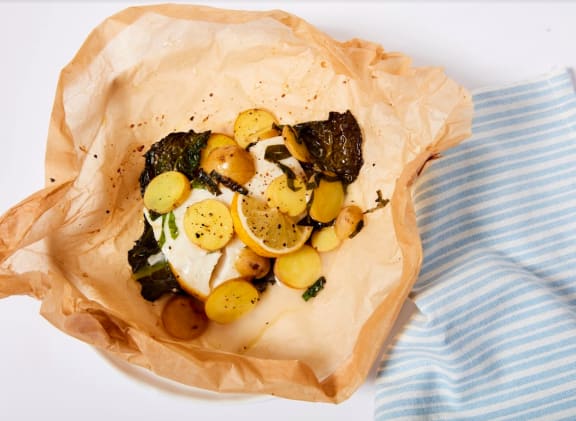If I had a penny for all the times I’ve uttered the phrase, “if I only knew then what I know now,” I’d be the proud owner of a big old barrell overflowing with pennies. The point is, I cherish and try to apply every morsel of knowledge I’ve ever managed to accrue, be it to benefit my personal growth, my career, my relationships and yes, even my cooking — which is especially true when it comes to cooking fish.
One of my favorite things about our monthly membership is the opportunity it gives me to regularly demystify, elevate, refine and experiment with my at-home seafood-cooking home. So let me hit you with some of the go-to hacks I’ve come across that have made me feel like a no-nonsense and masterful fish-cooking BOSS.
Moisture Master
Who likes a dried out piece of fish? No one, that’s who. So, some key tricks to help retain moisture in your fillets are always good to have up your sleeve. Poaching, for example, is an excellent cooking method that helps keep your fillets plump and juicy. Alternatively, if you’re broiling your fish in the oven, brushing it with a little seasoned mayonnaise is an optimal way to infuse it with flavor, while at once preventing it from drying out.
Splatter Patrol
Pan-frying fillets is a no-fuss and delicious way to get a nice sear and crispy skin going on your fillet, but that high heat setting can also lead to messy (and sometimes painful!) oil splatters. Enter cinnamon, the super condiment that, believe it or not, keeps the oil in your skillet from going berserk. Just add a healthy pinch to your pan, and cook with the confidence that your oil won’t pop (nor will your fish end up tasting like apple pie).
Craving Crispy
There are few things as satisfying to me as perfectly crispy salmon skin, which I now know isn’t as unfathomable as The Da Vinci Code. You can achieve crispy skin every time if you start cooking your fillet flesh-side down first on high heat (for that lovely sear), and in about 2 minutes it'll release easily from the pan so that you can flip it with a fish spatula. Allow it to cook flesh-side down for another few minutes, then enjoy immediately!
Smell Quelling
If the scent of fish cooking in your kitchen isn’t your thing, there are methods you can use to help you quell any smell (though, keep in mind that high-quality fillets should never smell fishy). Perhaps try baking your fillets in parchment, which not only contains all the flavors inside your parcel, but also any unwanted aromas you might be trying to avoid. Poaching is a great option here, too, with the poaching liquid behaving as a kind of absorption agent. Grilling is the most obvious smell-mitigating method, because it literally keeps the whole production outside of your kitchen.
Keepin’ it Together
Unlike people, it’s okay for fish to be flakey — but less so when your fillets start falling apart in the pan or on the grill. For more delicate species like cod or rockfish, for example, one great way to avoid this is by dipping your fillet into a simple beaten egg soak right before pan-frying it. Or if grilling, just place slices of lemon, or any other citrus, right on the grill and lay the fish on top. You can also cook your fillets on the grill in handy little aluminum foil packets; just think of these tips as a heat-protecting, flavor boosting barriers.
Bring on the Brine
Brining fish not only helps with the above issue of keeping the flesh intact, but it also has the added benefits of enhancing flavor and squeezing out albumin, a protein in fish, which is the white stuff that you sometimes see as the fillet cooks. Simply dissolve 1 tablespoon of salt per every cup of water to create an easy salt solution, then submerge the fillet and allow it to brine for just 10 minutes, perhaps while you're preheating the oven. After 10 minutes is up, pat the fillet very dry, then get cooking.
So there you have it — my full-on hack attack. Hope it’s helpful!
Live Wild (and stay resourceful!),
Monica
Pictured: our Pacific cod baked in a parchment parcel, where it had the chance to intimately mingle with a simple seasoning, baby kale, potatoes and the brightness of some lemon — a one-meal packet that turned out as delicious as it was easy to make.






